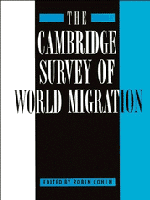Book contents
- Frontmatter
- Contents
- List of illustrations
- List of tables
- Notes on the contributors
- 1 Prologue
- 2 European colonization and settlement
- 3 Asian indentured and colonial migration
- 4 The great Atlantic migration to North America
- 5 Migration in Europe, 1800–1950
- 6 Migration in Africa
- 7 Latin and Central American migration
- 8 Migration to North America after 1945
- 9 Labour migration to western Europe after 1945
- 10 Repatriates and colonial auxiliaries
- 11 Migration in Asia and Oceania
- 12 Migration in the Middle East
- 13 Refugees from political conflict
- 14 Migrants and asylum-seekers in contemporary Europe
- 15 Emerging trends
- Acknowledgements and credits
- Index
3 - Asian indentured and colonial migration
Published online by Cambridge University Press: 05 December 2012
- Frontmatter
- Contents
- List of illustrations
- List of tables
- Notes on the contributors
- 1 Prologue
- 2 European colonization and settlement
- 3 Asian indentured and colonial migration
- 4 The great Atlantic migration to North America
- 5 Migration in Europe, 1800–1950
- 6 Migration in Africa
- 7 Latin and Central American migration
- 8 Migration to North America after 1945
- 9 Labour migration to western Europe after 1945
- 10 Repatriates and colonial auxiliaries
- 11 Migration in Asia and Oceania
- 12 Migration in the Middle East
- 13 Refugees from political conflict
- 14 Migrants and asylum-seekers in contemporary Europe
- 15 Emerging trends
- Acknowledgements and credits
- Index
Summary
Viewed on a global scale, unfree labour was the predominant form of labour control until a date much later than many might suppose. Even in Europe, Steinfield (cited Brass et al. 1993: 8) suggests that free labour, conceived in the sense of the freedom to choose one's employer, did not become a dominant legal ideal until the later eighteenth century and not the dominant paradigm until the nineteenth. Lucassen (in Brass et al. 1993: 10–18) alludes to three forms of productive unfree labour in the Old World and the Atlantic system – small-scale household, farm and artisan labour; large-scale plantation and mining labour; and unfree service as soldiers and sailors. As the same author notes, a number of scholars (for example, Paterson 1982, 1991; Curtin 1990) have demonstrated considerable continuities in the deployment of unfree labour. Moreover, a link between classical slavery and modern slavery has been established via Syria and Palestine, Cyprus, Sicily, Spain, the Azores and thence to the Americas.
Slavery disappeared in north-west Europe only to be replaced by servitude. The gradual progress to free labour and to independent economic activity in that part of Europe was, however, in marked contrast to the reintroduction of serfdom (the so-called ‘second serfdom’) in eastern Europe. Serfdom was only formally abolished in Poland in 1800 and in Russia in 1861. Naturally, legal prohibition concealed the continuation of other forms of unfree labour, including the ‘industrial slaves’ of the late nineteenth-century.
- Type
- Chapter
- Information
- The Cambridge Survey of World Migration , pp. 45 - 76Publisher: Cambridge University PressPrint publication year: 1995
- 9
- Cited by



